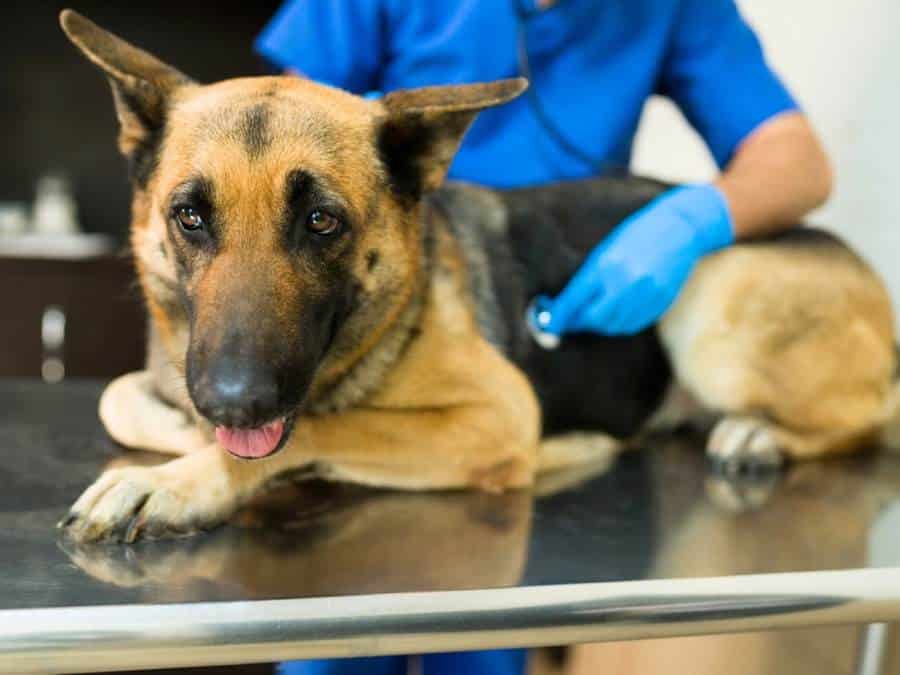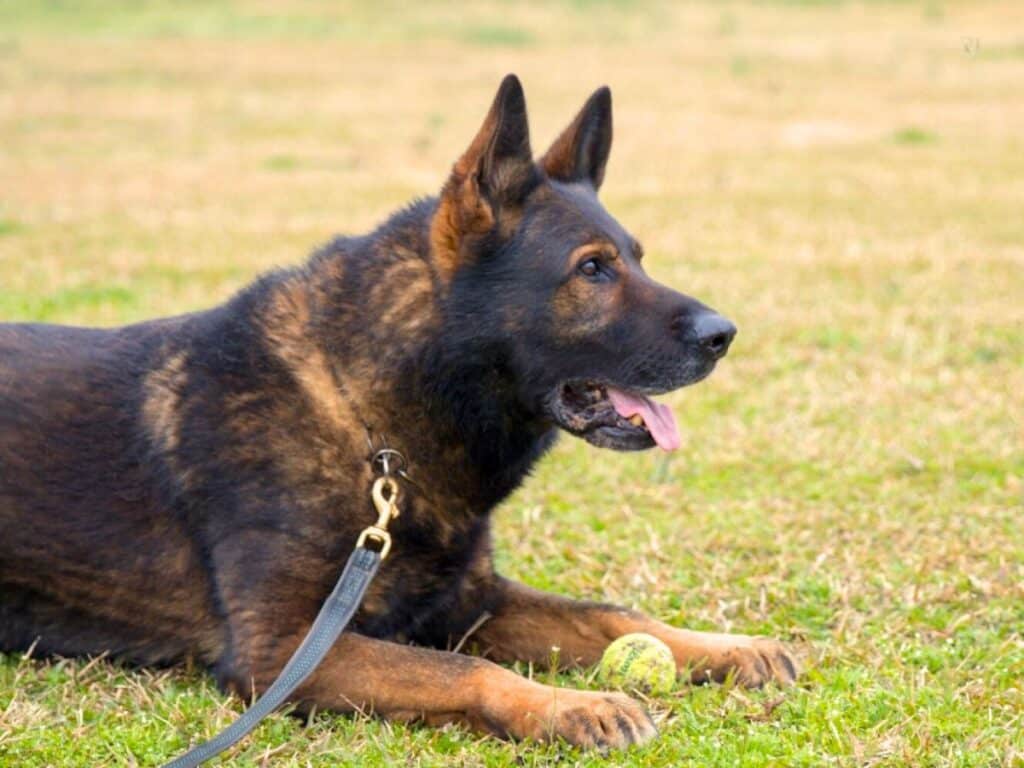Degenerative Myelopathy (DM) is a progressive neurological disease that primarily affects older shepherd dogs, typically around 8 years of age. This degenerative condition leads to hind limb weakness and paralysis over time, significantly impacting the quality of life for affected pets.
Unfortunately, there is currently no known cure for DM. However, understanding the symptoms and progression of this condition can help pet owners provide appropriate care and support to their beloved companions.
What is Degenerative Myelopathy?
Degenerative Myelopathy, also known as Canine Degenerative Radiculomyelopathy (CDRM), is a degenerative disease that affects the spinal cord in dogs. It is characterized by the gradual breakdown of the myelin sheath, which leads to nerve damage and subsequent loss of coordination and mobility.
This condition closely resembles Amyotrophic Lateral Sclerosis (ALS), a neurodegenerative disease seen in humans.
Just like ALS, degenerative myelopathy primarily affects the motor neurons in the spinal cord’s white matter. Over time, this progressive disorder causes muscle weakness and atrophy.
Initially, dogs with degenerative myelopathy may exhibit mild coordination issues such as stumbling or dragging their hind limbs while walking.
As the disease advances, these symptoms worsen and can eventually lead to complete paralysis. While German Shepherds are particularly predisposed to this condition, it can occur in other dog breeds as well.

Symptoms of Degenerative Myelopathy in German Shepherds
The symptoms of degenerative myelopathy (DM) in German Shepherds and other affected breeds typically progress slowly over time. It’s essential to note that not all dogs with DM will exhibit every symptom, and the severity and progression of the disease can vary. The primary symptoms include:
Early symptoms of DM
- Mild Weakness: Initially, there may be mild weakness in the hind limbs. This can manifest as dragging of the back feet or an unsteady gait.
- Loss of Coordination: Dogs may show signs of unsteadiness or difficulty maintaining balance, particularly in the hindquarters.
Progressive symptoms
- Worsening Weakness: As the disease progresses, weakness in the hind limbs increases. The dog may have difficulty rising or may stumble while walking.
- Ataxia: Ataxia refers to a loss of coordination. Dogs with DM may exhibit ataxia in their hind limbs, making it challenging to walk or maintain balance.
- Dragging of Feet: The dog may drag its back feet while walking, and the nails on the hind paws may wear down more quickly.
One of the primary symptoms of degenerative myelopathy in German Shepherds is difficulty walking and maintaining balance. As the disease progresses, you may notice that your furry friend starts to struggle with their mobility. They may have a hard time getting up from a lying position or experience weakness in their hind legs.
Advanced symptoms of DM
- Paralysis: In the later stages of DM, the hind limb weakness can progress to paralysis. Dogs may lose the ability to stand or walk.
- Loss of Bladder and Bowel Control: As the disease advances, control over bladder and bowel function may be lost, leading to incontinence.
- Muscle Atrophy: Muscles in the hind limbs may start to atrophy (shrink) due to lack of use.
It’s crucial to recognize that these symptoms are not exclusive to DM, and other conditions with similar clinical signs, such as spinal cord tumors or intervertebral disc disease, should be ruled out through diagnostic tests.
If you observe any of these symptoms in your German Shepherd or suspect degenerative myelopathy, it’s important to consult with a veterinarian. Early diagnosis can help provide supportive care and improve the dog’s quality of life.
RELATED: Common German Shepherd Health Issues

What Causes Degenerative Myelopathy in Dogs?
While the exact cause of DM is still not fully understood, researchers have identified several factors that contribute to its development.
1. Genetic mutation associated with SOD1 Gene plays a role
The SOD1 gene encodes an enzyme called superoxide dismutase 1, which plays a crucial role in protecting cells from oxidative stress. However, in dogs affected by DM, this gene undergoes a mutation that leads to the production of abnormal proteins.
These abnormal proteins accumulate within nerve cells, causing damage and ultimately leading to the degeneration of the spinal cord.
The accumulation of these proteins disrupts normal cell function and impairs communication between nerve cells, resulting in the characteristic symptoms observed in dogs with DM.
2. Inheritance pattern suggests it is an Autosomal Recessive Trait
This means that for a dog to develop DM, it must inherit two copies of the mutated gene – one from each parent. Dogs carrying only one copy of the mutated gene are considered carriers but do not typically show symptoms themselves.
Understanding this inheritance pattern is crucial for breeders who want to reduce the incidence of DM within their breeding lines.
By selectively breeding only those dogs without any copies or carriers with unaffected mates, breeders can lower the risk of passing on this debilitating condition to future generations.
3. Other factors (age, breed, & environment)
DM typically affects dogs between the ages of 8 and 14, although it can occur in younger dogs as well.
Certain breeds, such as German Shepherds, Boxers, and Pembroke Welsh Corgis, appear to be more susceptible to developing DM compared to others. However, it is important to note that DM has been reported in various other breeds as well.
Environmental factors may also play a role in the development of degenerative myelopathy. While there is no direct evidence linking specific environmental factors to DM, factors such as diet, exercise levels, and overall health can influence a dog’s susceptibility to the disease.
RELATED: What Do German Shepherds Usually Die From?

Diagnosing Degenerative Myelopathy in German Shepherds
The diagnosis of degenerative myelopathy (DM) in German Shepherds involves a combination of clinical evaluation, ruling out other potential causes of similar symptoms, and sometimes genetic testing. Here is an overview of the diagnostic process:
1. Clinical evaluation
- A veterinarian will conduct a thorough physical examination, focusing on the dog’s gait, reflexes, and overall neurological function.
- The characteristic clinical signs of DM include hind limb weakness, ataxia (loss of coordination), and difficulty with balance and walking.
2. Medical history
The veterinarian will gather information about the dog’s medical history, including the onset and progression of symptoms, any recent injuries or illnesses, and changes in behavior.
3. Rule out other conditions
Because the symptoms of DM can resemble those of other spinal cord diseases or orthopedic issues, the vet will perform tests to rule out alternative causes. These may include X-rays, MRI (magnetic resonance imaging), or CT (computed tomography) scans of the spine.
Blood tests may also be conducted to rule out infectious or inflammatory diseases that could affect the nervous system.
4. Genetic testing
Genetic testing is available to identify the SOD1 mutation associated with degenerative myelopathy. While the presence of the mutation increases the risk of developing DM, it doesn’t guarantee that a dog will develop the disease.
Genetic testing can be useful, especially in breeding programs, to identify carriers and affected individuals. It is typically done through a simple blood sample or cheek swab.
5. Cerebrospinal fluid analysis
In some cases, a sample of cerebrospinal fluid may be collected through a spinal tap (lumbar puncture) to analyze if there are any abnormalities that could suggest a spinal cord disease.
6. Electromyography (EMG) and Nerve conduction studies
These tests measure the electrical activity of muscles and nerves, respectively. They can help assess the function of the nervous system and may be used to support a diagnosis of DM.
It’s important to note that degenerative myelopathy is a diagnosis of exclusion, meaning that other potential causes of similar symptoms must be ruled out before reaching a conclusion. The process may involve collaboration between the veterinarian and specialists, such as neurologists.
If you suspect that your German Shepherd may be showing signs of degenerative myelopathy, it’s crucial to consult with a veterinarian promptly.

Treatment Options for German Shepherd Degenerative Myelopathy
Unfortunately, there is no cure for degenerative myelopathy (DM) in German Shepherds or other affected breeds. The disease is progressive and irreversible.
However, there are supportive care measures that can help manage the symptoms and improve the affected dog’s quality of life. Treatment options may include:
1. Physical therapy
Physical therapy and rehabilitation exercises can help maintain muscle mass, improve range of motion, and enhance overall mobility. Exercises may include assisted walking, swimming, and passive range-of-motion exercises.
2. Assistive devices
Mobility aids such as carts or harnesses can assist dogs with DM in maintaining their ability to walk. These devices can provide support for the hind limbs, allowing the dog to continue to move independently.
RELATED: How To Make German Shepherd Back Legs Stronger?
3. Exercise and activity modification
While it’s essential to keep affected dogs active, it’s equally important to avoid excessive exercise that could lead to fatigue or injury. Controlled and low-impact activities are generally recommended.
4. Management of incontinence
As DM progresses, affected dogs may lose control over their bladder and bowel function. Diapers, belly bands, or other incontinence management strategies may be used to address these issues.

5. Pain management
Pain relief may be necessary, especially if the dog experiences discomfort associated with muscle atrophy or other secondary issues. Your veterinarian may prescribe pain medications or recommend other pain management strategies.
6. Nutritional support
Maintaining a healthy and well-balanced diet is important for dogs with degenerative myelopathy. Some veterinarians may recommend specific nutritional supplements to support joint health and overall well-being.
7. Emotional and environmental support
Providing a supportive and comfortable environment is crucial for dogs with DM. This includes easy access to food and water, soft bedding, and minimizing obstacles in the living space to prevent falls.
It’s important to work closely with a veterinarian to develop a comprehensive care plan tailored to the specific needs of the individual dog. Regular veterinary check-ups are essential to monitor the progression of the disease and make adjustments to the treatment plan as needed.
What is the prognosis of Degenerative Myelopathy in dogs?
Degenerative Myelopathy (DM) is a progressive disease that unfortunately carries a poor long-term prognosis for affected dogs. As the disease progresses, it eventually results in complete paralysis and a significant decline in the dog’s quality of life.
The prognosis for DM can vary depending on several factors, including the individual dog’s condition and response to treatment. However, on average, dogs diagnosed with DM typically have a lifespan ranging from six months to three years.
While there are various treatment options available to alleviate symptoms and slow down disease progression, they cannot reverse or halt the degenerative process entirely.
Therefore, it’s essential for pet owners to understand that DM remains a progressive condition with limited treatment outcomes.
It’s important to note that each case of DM is unique, and some dogs may respond better to treatment than others. Some key factors influencing prognosis include:
RELATED: What Is The Average Lifespan of German Shepherds?
Which dog breeds are predisposed to DM?
Degenerative myelopathy (DM) is a condition that can affect several dog breeds, but some breeds are more predisposed to it than others. The most commonly affected breeds include:
- German Shepherd
- Boxer
- Pembroke Welsh Corgi
- Rhodesian Ridgeback
- Chesapeake Bay Retriever
- Standard Poodle
- Bernese Mountain Dogs
Keep in mind that while these breeds are more commonly associated with degenerative myelopathy, the condition can still occur in other breeds, albeit less frequently.
Responsible breeding practices, genetic testing, and early detection can help manage and reduce the incidence of degenerative myelopathy in these breeds.
Also Read: Pannus in German Shepherds: Symptoms and Treatment

How does DM in dogs relate to increased panting?
Degenerative myelopathy (DM) primarily affects the spinal cord and nervous system in dogs, leading to progressive hind limb weakness, loss of coordination, and other neurological symptoms.
Panting, on the other hand, is a normal behavior in dogs and can be influenced by various factors unrelated to DM. It’s important to understand that panting itself is not a specific symptom of degenerative myelopathy.
However, as the disease progresses and a dog’s mobility is compromised, you may observe changes in their breathing patterns and panting behavior.
Also read:
- German Shepherd Hip Dysplasia: Signs & Treatments
- German Shepherd Elbow Dysplasia: Symptoms & Treatment
Do dogs with DM whine more?
Degenerative myelopathy (DM) in dogs, characterized by progressive hind limb weakness, can lead to changes in behavior, including whining. Whining in dogs with DM may be a response to various factors such as pain, discomfort, anxiety, or frustration associated with the disease.
Dogs may use vocalizations to communicate their needs, seek attention, or express their emotional state. It’s essential for dog owners to observe their pet’s behavior closely and consult with a veterinarian if they notice persistent or concerning whining.
The veterinarian can assess the dog’s condition, address any pain or discomfort, and provide guidance on supportive care measures to enhance the dog’s overall well-being as the disease progresses.
Degenerative Myelopathy Test for Dogs
There are several tests used to diagnose or assess the risk of degenerative myelopathy (DM) in dogs. These tests include clinical evaluation and genetic testing. Here are the main types of tests involved:
1. Clinical evaluation
A veterinarian will conduct a thorough physical examination, focusing on the dog’s gait, reflexes, and overall neurological function. This evaluation helps identify clinical signs associated with degenerative myelopathy.
2. Genetic testing
Genetic testing is available to identify the presence of the SOD1 mutation associated with degenerative myelopathy. This test can determine if a dog carries one or two copies of the mutation, providing information about the dog’s risk of developing DM.
A simple blood sample or cheek swab is usually collected for genetic testing. This type of testing is particularly useful in breeds with a known predisposition to DM, such as German Shepherds.
3. Electromyography (EMG) and Nerve conduction studies
These tests measure the electrical activity of muscles and nerves, respectively, and can help assess the function of the nervous system. While not specific to DM, they can support a diagnosis based on clinical signs.
4. Histopathology (Post-mortem examination)
A definitive diagnosis of degenerative myelopathy can be confirmed through a post-mortem examination of the spinal cord. This is not a practical diagnostic tool during a dog’s lifetime but can provide conclusive evidence of DM.
It’s important to note that genetic testing is particularly valuable for identifying the risk of degenerative myelopathy before clinical signs appear.
Conclusion
In conclusion, Degenerative Myelopathy is a progressive and debilitating disease that affects the spinal cord of our beloved German Shepherd dogs. It can cause a range of symptoms, including weakness in the hind legs, difficulty walking, and loss of coordination. While there is no cure for this condition, early diagnosis and appropriate treatment can help manage the symptoms and improve your dog’s quality of life.
Also, remember that you are not alone in this journey; there are support groups and online communities where you can connect with other owners facing similar challenges.
Frequently Asked Questions (FAQs)
1. Can degenerative myelopathy be prevented?
While degenerative myelopathy cannot be prevented entirely since it has a genetic component, certain measures can help reduce the risk or delay its onset. These include maintaining a healthy weight for your dog, providing regular exercise to keep their muscles strong, and avoiding excessive stress on their spine.
2. Are all German Shepherds prone to developing degenerative myelopathy?
No, not all German Shepherds will develop degenerative myelopathy. However, they are considered one of the breeds at higher risk for this condition due to genetic factors.
3. Is degenerative myelopathy contagious?
No, degenerative myelopathy is not contagious. It is an inherited disease that results from specific gene mutations passed down through generations.
4. Can physiotherapy help manage the symptoms of degenerative myelopathy?
Yes, physical therapy can play a significant role in managing the symptoms of degenerative myelopathy in German Shepherds. It aims to maintain muscle strength and flexibility while improving overall mobility and quality of life for your dog.
5. Should I consider euthanasia if my German Shepherd has degenerative myelopathy?
Deciding on euthanasia is a deeply personal and difficult decision. It is essential to consult with your veterinarian, who can assess your dog’s quality of life and provide guidance based on their expertise and knowledge of your pet’s condition.
Also read:




